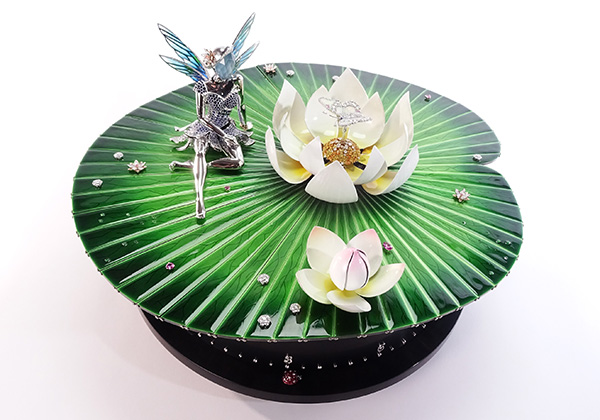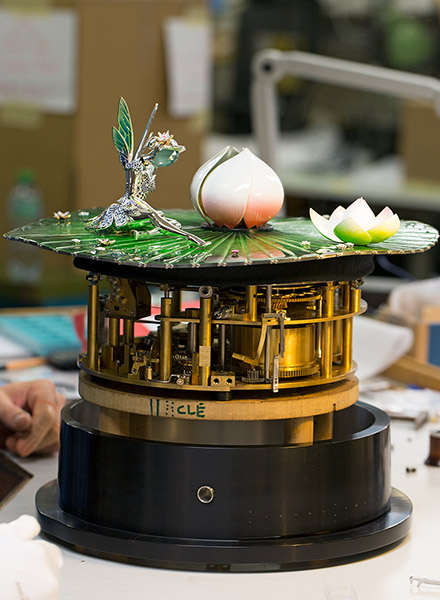One of the stars of the last SIHH was neither a watch, a watchmaker nor a celebrity ambassador. It was a fairy. The Fée Ondine by Van Cleef & Arpels dispensed with all the usual superlatives of the Salon: it wasn’t the most beautiful, the most poetic or the most technical – it was simply... unique. An island of whimsy in an ocean of complications, a purely creative exercise in a deluge of new launches, a timeless object amid the watches du jour. Why did Van Cleef & Arpels make the Fée Ondine? No reason. Simply because it is beautiful. Because Van Cleef & Arpels is one of the last maisons prepared to make beautiful things, just to delight its clients.
The Fée Ondine is nevertheless an extraordinarily complex creation. It may not be considered seemly to examine the underside of a fairy, but WorldTempus took the time to talk to Van Cleef & Arpels Director of Development, who supervised the design of the automaton, in a process that was full of surprises and changes of direction.
59 shades of green
First of all, we were completely unprepared for the complexity of the lily pad. It is made up of 59 separate enamelled strips. Each one is a different length, and has to be adjusted extremely precisely. When they were fired, we found we had gaps of several millimetres between each strip! Most people are aware how difficult it is to make an enamel watch dial, which has to be a given thickness, with microscopic tolerances. Imagine this exercise multiplied by 59, with pieces so big that no one knew how to do it. Until now.
A matter of proportion
If the size of the different elements of the Fée Ondine appears obvious, that’s great! But it wasn’t always like that. We made a number of models before we hit upon the right proportions. The crux of the issue was the size of the Fairy in relation to the lily pad. We made many, many attempts.

No Plan B
The enamel work for the lily petals was very complex. We kept searching and searching for the right material (which had to be perfectly regular) and colours (as we imagined them). The outer petals of the lily flower were particularly difficult to get right. Originally, we had thought of using petrified wood for the case of the automaton movement. Unfortunately, we discovered that wood, even fossilised wood, has a shape memory, and we were unable to carve it into the angles we needed for our design. In the end, ebony proved to be more forgiving, while providing a magnificent visual effect.
Pulverised enamel
In order to produce the different shades of green enamel, from the lightest hues in the centre, growing darker towards the edges, we couldn’t apply the enamel in the traditional fashion, with a brush. To achieve a soft and gradual colour gradient, we perfected a system using pulverised powder. The darker tones are obtained by applying more coats than the lighter shades. The leaf veins are engraved.
Grace and rigidity
The beauty of an automaton lies in how it moves. It was a real challenge to bring this fairy made of gold encrusted with gems, an absolutely rigid figure, to life. Our partner François Junod employed his mastery of mechanics to gracefully animate our fairy.

A topsy-turvy oven
The enamel blades of the lily pad are so long that they didn’t fit inside a traditional enamel kiln. They had to be suspended vertically for firing. So we decided to flip our kiln onto its front, so that it stood vertically. It worked!
Countless hours
Our CEO Nicolas Bos trusted us implicitly. His original idea was to bring the piece out for the SIHH 2016, but we didn’t think the Fée Ondine was ready. He didn’t hesitate for a moment to postpone the launch to the SIHH 2017, the following year. Overall, we spent a little more than 12,000 hours on the Fée Ondine, which has a total of 2870 different parts.
Traditional craftsmanship
The Fée Ondine was created with hardly any CAD (computer-assisted design) tools. We had to coordinate fifteen or so different artistic crafts, all of which had their own constraints. CAD wouldn’t have helped us much. We worked in the old-fashioned way, coming together once a month to check on progress.
The first stone
This project was actually the catalyst for the creation of an Objects department. The Fée Ondine is its first creation. We don’t have any concrete plans for the future, but we do have lots of ideas. We are using a lot of the expertise we have acquired through our Haute Joaillerie work.






